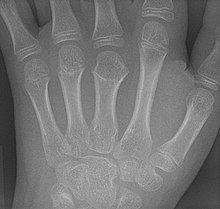Brachymetacarpia
You can help expand this article with text translated from the corresponding article in Spanish. (August 2022) Click for important translation instructions.
|

Brachymetacarpia or brachymetacarpalia is a medical condition in which the metacarpal bones of the hands are shortened.[1] The equivalent condition in the foot is brachymetatarsia, in which the metatarsal bones are shortened. Brachymetacarpia is typically congenital and presents in childhood or early adolescence, but it can also be associated with other acquired syndromes or endocrinological conditions. While cosmetic appearance is the most common concern of affected individuals, brachymetacarpia may also affect hand function due to alterations in muscle and tendon length. Treatment usually involves lengthening of the affected bone(s), either acutely with a bone graft or gradually with an external fixator.[2]
This condition is one of the causes of brachydactyly.
Epidemiology
Prevalence of brachymetacarpia is unknown. The third, fourth, and fifth metacarpals are most commonly affected.[2]
References
- ^ Rayan, Ghazi M.; Upton III, Joseph (2014), Rayan, Ghazi M.; Upton III, Joseph (eds.), "Brachymetacarpia", Congenital Hand Anomalies and Associated Syndromes, Berlin, Heidelberg: Springer, pp. 279–290, doi:10.1007/978-3-642-54610-5_20, ISBN 978-3-642-54610-5, retrieved 2022-12-02
- ^ a b Barik, S; Farr, S (4 Jan 2021). "Brachymetacarpia and brachymetatarsia: do we need to operate?". EFORT Open Reviews. 6 (1): 15–23. doi:10.1302/2058-5241.6.200087 (inactive 1 November 2024). PMC 7845563. PMID 33532083.
{{cite journal}}: CS1 maint: DOI inactive as of November 2024 (link) CS1 maint: multiple names: authors list (link)